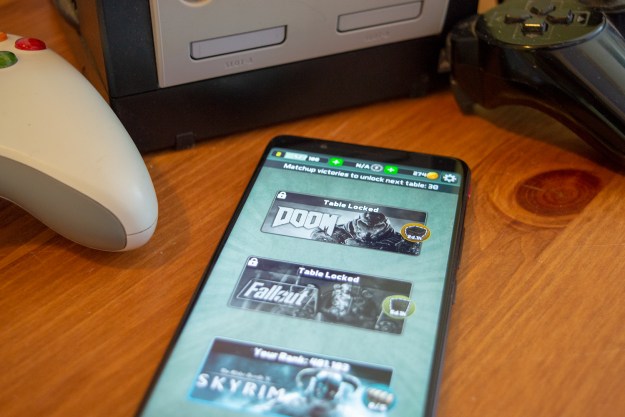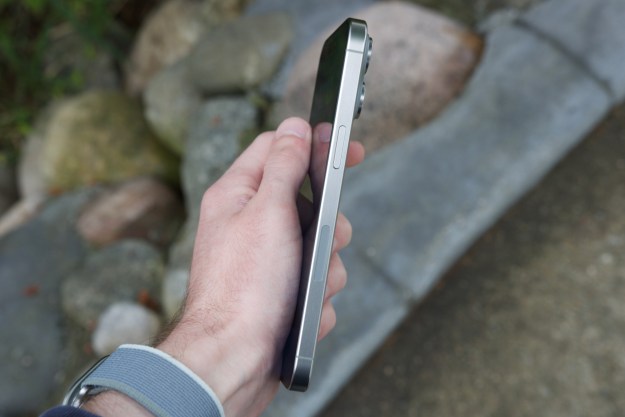
- Unique design
- Loud speakers
- Great performance
- Long-lasting battery
- Good cooling system
- Disappointing low-light camera
- Slippery metal build that easily scuffs up
- No NFC for Google Pay
Everyone and their mother is making a gaming smartphone these days, which usually means a high-powered processor that prioritizes performance for graphics-intensive games, plus some other features gamers would appreciate. Samsung has pushed this with the Note 9, there’s the Honor Play, last year we saw the Razer Phone, and there’s more to come like the Asus ROG Phone, and the Xiaomi Black Shark.
Add a new one to the list: The Red Magic Phone, from ZTE sub-brand Nubia. It has an innovative cooling system, a game-boosting mode, an RGB LED light strip, and a mid-range price tag. It delivers with performance, but we’re not sure if it’s quite the bargain when phones like the OnePlus 6 exist. Let’s take a closer look.
Unique and flashy design, scuffs easily
Place the Red Magic Phone down on a surface, and you’ll notice it rocks significantly. That’s because of its unique design. The back isn’t flat, as the top and bottom edges slope downwards to form a prism, with a long RGB strip running down the center.
We’re quite impressed with the Red Magic Phone’s look, and the hexagonal-shaped camera is icing on the cake. Despite its large size, the phone is comfortable to hold, and our fingers slipped nicely into place along the phone’s slopes.
That said, the Red Magic Phone does rock a lot when laid down, making it difficult to use on a flat surface, and the anodized metal finish makes it quite slippery in the hand. While the metal will likely prove more durable than glass phones, this is one of the first phones we’ve seen to scratch so easily by keys in a pocket. We don’t think this phone will look too good after a year of use with just regular wear and tear.
We’re fans of the way ZTE found a unique design without compromising on the Red Magic Phone’s usability.
The front of the Red Magic Phone isn’t as interesting. A 6-inch screen is surrounded by slim bezels, and precious little else aside from the front-facing camera. The bezels aren’t the slimmest we’ve seen, but it still looks contemporary. The power button is on the right-hand side, underneath the volume rocker. There’s also an extra button highlighted in red on the right edge, and it controls the Gameboost setting, which we’ll get to later. A USB Type-C port sits at the bottom, and a headphone jack rests at the top, which is always nice to see.
The LED strip on the back is capable of displaying 16 million colors in four different light effects. There are a few options that govern when the strip will activate, but it will generally light up during games, while charging, or to signal when notifications arrive. It’s quite similar to the RBG light on the back of the Asus ROG Phone.
You’re unlikely to see the strip yourself most of the time, since it’s located on the back of the phone. It’s a gimmick, and largely serves to increase the “gamer cred” look of the Red Magic Phone. That doesn’t stop it from looking cool when it lights up, though.
Take a closer look at the back, and you’ll find four red slashes, neatly placed leading up the phone’s central ridge. These aren’t just for looks — the top two function as exhaust ports for the device’s cooling system. The phone uses layers of graphite to draw heat away from components, which is then flushed out of the system through the exhaust ports and the additional surface area of the prism-shaped back.
It’s quite effective. We tested the Red Magic Phone with some intense virtual reality experiences with a third-party VR headset, and the phone stayed cool. Our Galaxy S8 — which has the same processor — grew increasingly hot to the touch during the same experiences.
Decent display, loud speakers
The Red Magic Phone’s 6-inch LTPS IPS LCD display runs a 2,160 x 1,080 resolution in an 18:9 aspect ratio. LTPS — or low-temperature polycrystalline silicon — is a type of LCD display that runs cooler than normal LCD displays. Aside from that, the screen is nothing special. There’s no special 120Hz display magic like we saw on the Razer Phone, and it’s nowhere near as good as the Galaxy Note 9’s AMOLED screen.
We had no problems seeing the screen in direct sunlight, but it didn’t get dim enough. Open the Red Magic Phone at night on low brightness and you’ll be blinded. The auto brightness feature also didn’t work particularly well, as it often failed to adjust the screen based on surrounding light levels.

These are small flaws — the Red Magic Phone’s screen is still clear, bright, and colorful. It’s not the sharpest, but it’s more than crisp enough to make out the smallest details on your mobile games or favorite apps. It’s just odd the company didn’t try to add a better display or a higher resolution, seeing as it’s what you’ll be looking at the most when playing games.
Thankfully, the speakers offer a more impressive experience. Audio comes out of the two lower slits on the back of the phone. It gets extremely loud — when placed on the loudest notification volume, we could clearly hear the phone chime from three rooms away. Nubia has also added a bunch of features to boost audio quality, including an integrated DAC, DTS Technology, and a Smart Amplifier system.
The positioning and shape of the device also means you’re likely to cup the speakers with your hand when holding the phone in landscape, rather than block them. This forms a rough sound chamber that makes everything sound even louder, not that the phone needs it. The speakers are crystal clear, with acceptable bass and treble, and exceptional volume.
Strong performance from older hardware
The Red Magic Phone is powered by Qualcomm’s Snapdragon 835, and comes with either 6GB of RAM and 64GB of storage, or 8GB of RAM and 128GB of storage. There’s no MicroSD card slot though, so keep that in mind when selecting your model.
With light usage, it wouldn’t be surprising for this phone to last over two days on a single charge.
The choice of last year’s flagship Snapdragon 835 chip over this year’s Snapdragon 845 is odd, especially in a phone meant for high-performance gaming. Surely a gaming phone would want the latest grunt to power through the most demanding games? Nubia claims the Red Magic Phone is not the most powerful phone for gaming — but the most stable. It said the Snapdragon 835 is the best choice in a balance of power, battery consumption, and temperature management. We never ran into problems with phones using the Snapdragon 845, but we also haven’t run into any problems with the Red Magic Phone.
Performance is smooth, apps open quickly, and we haven’t seen any significant slowdown in our use. That speed is at least partly to do with the slim Android 8.1 Oreo operating system. There’s no bloatware or skin; it comes with Google apps and the basics installed. You’ll find extra settings categories for the RGB light and the Gameboost mode, but that’s about it.
Here are a few benchmark results:
- AnTuTu 3DBench: 215,454
- Geekbench 4 CPU: 1,935 single-core; 6,636 multi-core
- 3DMark Sling Shot Extreme: 2,841 (Vulkan)
Nubia said it optimized the Snapdragon 835 in its phone, and that optimization shows. The benchmark numbers exceed most other Snapdragon 835-equipped phones, including the recent Moto Z3, and the Google Pixel 2.
But the Red Magic Phone is built to game, and we have to tackle the question eventually: how good is it as a mobile gaming device? We threw the most demanding games we could find at it, playing multiple rounds of Tekken, Asphalt Legends 9, and Dragonball Legends, and the Red Magic Phone handled each of them incredibly well, with silky-smooth performance. We even managed to get a game of Rocket League running using the Steam Link Android app and USB OTG support to connect a controller to the phone.

It wasn’t perfect, though. It did have some issues running PUBG Mobile, hitting a few frame hitches during the initial parachuting sequence, but it ran as smoothly as the other games after that — this may not be the phone’s fault, but more the app developer.
The Red Magic Phone is equipped with Bluetooth 5.0, but there’s no NFC. That means you can’t make contactless payments through Google Pay. It’s a shame to see this missing, as several phones in its price range — and cheaper devices — have this feature.
Gameboost mode
Also included with the Red Magic Phone is the Gameboost mode, activated by flicking the red switch on the right-hand side of the phone. It’s supposed to boost gaming performance by forcing a more stable framerate, blocking notification alerts, and increase app loading times. Since the Red Magic Phone’s performance was already so smooth, we didn’t notice much difference whether the mode was on or not. We mostly used the mode as a way to show off the LED strip, and block notifications during gameplay.
A decent camera with low-light issues
The camera is the weakest part of the Red Magic Phone, perhaps unsurprisingly. It’s a single 24-megapixel lens with an f/1.7 aperture. We love the hexagonal rim and red highlight around the lens, though it does slightly protrudes from the back.
It performs well in good lighting, giving us photos with good color accuracy and detail. While there’s no second lens for depth-of-field emulation, the Red Magic Phone has a bokeh mode that adds blur behind subjects. It’s hit-and-miss as it has trouble accurately placing the background blur.
The lack of optical image stabilization (OIS) really hampers the camera, and you’ll struggle to take decent shots if your target is moving. The HDR mode also tends to overexpose, and things take a turn for the worse in low light. The camera struggled to find a good focus point on a well-lit seafront, resulting in a photo with lots of blur and plenty of noise.
The camera app is fast and responsive, however, and there’s hardly any shutter lag. It’s a little barebones compared to other apps, but you’ll still find a decent suite of features here. Pro mode lets you alter the shutter speed and ISO, and video recording goes up to 4K.
The 8-megapixel selfie camera takes decent photos, but it tends to overexpose — especially the sky. The Beauty mode is also a little heavy-handed, and we looked a bit plastic in a few of our snaps.
All-day battery life and more
The Red Magic Phone comes with a huge 3,800mAh battery that should ensure your gaming sessions are never cut short by a flat battery. We took the phone off the charger at 8 a.m., and after a day of heavy to medium usage watching YouTube videos, music streaming, some light gaming, and instant messaging, it ended the day at 8 p.m. with more than 60 percent battery left. It managed to last until midday the next day, when it hit 15 percent and was plugged in to charge.
You’ll find no wireless charging here, but the phone does support Quick Charge 3.0. Charging from 13 percent with the included charger, it reached 100 percent in less than an hour and half.
Price, availability, and warranty information
The Red Magic Phone costs $520, but it’s not available in the U.S. just yet. A version is being made for the U.S. market, and it will be available on the Red Magic store when ready. Otherwise, it’s available in Europe including the U.K. starting on September 7. The phone was crowdfunded through Indiegogo, and phones have already shipped out to early backers.
Nubia offers a two-year warranty on the phone, and a year on the included charger. Network availability hasn’t been confirmed yet, but the initial reports suggest that it’ll work on every network — but we’ll confirm that closer to the U.S. launch.
Our Take
The Red Magic Phone delivers excellent performance, a strong battery, great speakers, and a neat design. The weak camera doesn’t stop this from being a solid mid-range smartphone.
Is there a better alternative?
Yes. The OnePlus 6 comes with the upgraded Snapdragon 845, a beautiful design, and a much more capable set of cameras. It doesn’t have the Red Magic Phone’s RGB strip, and its speakers aren’t anything to write home about, but it’s the stronger overall phone, and it’ll also game extremely well. If you’re looking to buy in the $500 range, the OnePlus 6 is a tough phone to pass over.
If you’re looking to stick with the gamer-focused branding, then check out the Razer Phone. It has the same processor as the Red Magic Phone, great speakers, and a display with an incredible 120Hz refresh rate. It initially cost $700, but you can find it on Amazon for $550.
Not limited in budget, and simply want a great phone? Check out the Galaxy Note 9, or the rest of our picks in our best smartphones guide.
How long will it last?
We don’t think Red Magic Phone will look good after quite a bit of use, as it has easily scuffed up after a short period of time. It’s metal body is still more durable than glass, but you may still want to grab a case.
The Red Magic Phone will be receiving Android 9.0 Pie at an unspecified date in the future, though we’re not sure what other updates it will receive afterwards. With that in mind, the Red Magic Phone’s slim OS and powerful innards should last you two to three years.
Should you buy it?
It’s difficult to recommend this phone over the OnePlus 6. The only reason you should consider the Red Magic Phone over it is if you’re really sold on the unique design, RGB strip, and gaming-focus, and if you do go for it, we think you’ll be satisfied.
Editors' Recommendations
- Best phone deals: Save on the iPhone, Galaxy Z Fold 5, and more
- Can you take a picture of the solar eclipse with your phone? Here’s how to do it
- The 10 best apps for a second phone number in 2024
- Best Samsung Galaxy S24 deals: Save up to $800 on the phone
- Will my phone change for daylight saving time automatically?













